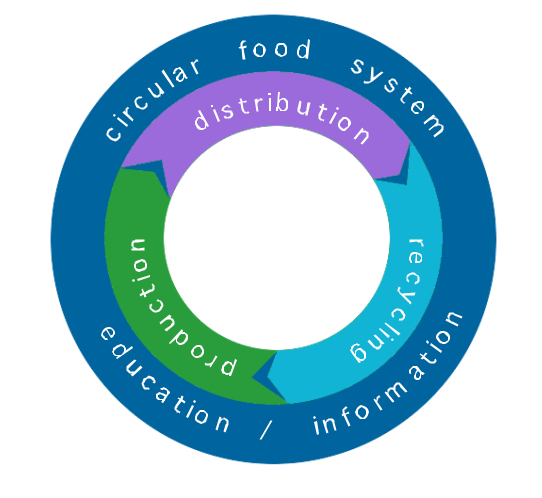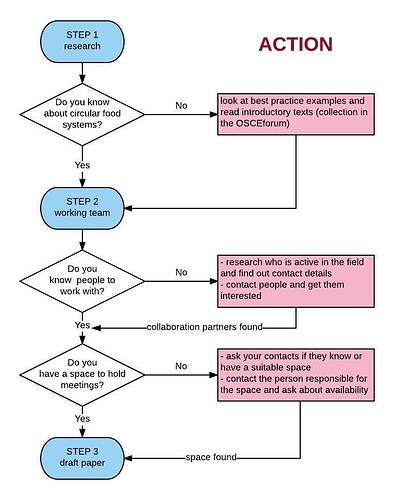

META: We are in the process of developing an ACTION Protocol on How To Write A Food Policy Paper (‚edible city’, ‚urban agriculture’). The finished ACTION will be developed and posted here. For now we are working on a first practical example for Berlin. Once the Berlin paper is finished we will condense the learning from that paper into a general paper posted below.
Till then below we store a loose material collection.
Follow the open development of our practical example and join the process here.
##Material & Idea Collection
. . .
STEP 1 – study and fill in the ACTION Template & Criteria
2 Short Summary
TASK: Draft a policy paper for feeding the city sustainably that involves as many input perspectives as possible. Draft definitions for terms like ‘urban agriculture’ and ‘edible city’ for your local conditions. Get a broad range of stakeholders to comment and work on a draft paper to extend it and add their perspectives.
AIM: Define the longterm strategy for making the food system of your place circular. Involve and connect local stakeholders in a network you can later use to plan the realization of the strategy and make it happen.
OUTCOME: A policy paper that can be published, promoted and presented at a public event.
3 Author Name: Created by Maike (@transitionmaike)
4 Introduction & Background:
Food is one of the most essential needs in a circular economy. Writing a policy paper can get local stakeholders (food producers such as farmers, food distributors such as logistics companies and shops, nutrient recyclers such as water works and composting facilities) involved in
- creating a shared positive vision for a desirable future
- defining realistic steps to achieve the envisioned future
- thinking about their own potential to contribute to the circular city ecnomy
- each starting with implementing their own contribution
- getting together to coordinate the shared effort
- keeping on track in future by having a strategy written down
5 Resources Needed_
- acess to computer, internet, phone and other communication tools
- meeting spaces (preferably free)
- contacts to stakeholders (preferably personal)
- people with research skills
- people with good communication skills
- people with good writing skills
- people with moderating skills
- people with expertise in the field
- time and patience
6 STEPS_
STEP 1 – Get Started: Research
There are 2 possible ways to start:
a) you already know all about the subject of edible cities, urban agriculture, nutrient recycling and circular food systems.
b) you only know some bits or have no idea what it actually means
A) move on to STEP 2
B) find out about best practise examples and read some introductory texts (we’ll collect these here on the platform soon)
STEP 2 – Create a team
a) you don’t know anyone who works in the field
b) you already have a network of people interested in circular food systems
A) research who is already active in your area. Find out their contact details and then move on to B)
B) make a list of people you want to work with closely when you try out the ACTION. Find out if they are interested, talk to them and get them to join a meeting
STEP 3 – Set up a working team collaboration
a) you don’t have a space and you have no experience in organising meetings
b) you don’t have a space but you know how to organise meetings
c) you have a space and know how to organise meetings
A) ask the people you contact if they have a space and/ or experience to help you with this step. If they do, move on to C)
B) research which space you could use for meetings that are convenient for all the people you want to include in the working team (opening times, location). Spaces can be public parks, community centres, office spaces of affiliated projects, local church halls, local libraries, even school or kindergarden rooms… be creative and don’t hesitate to ask. Just make sure it’s free as you don’t want to start out by having to organise a budget. Once you found a space, move on to C)
C) Organise an offline meeting of the working team. You may also want to set up an online collaboration platform (e.g. a topic on the OSCEplatform, a Loomio-group… anything that helps you to communicate, document your discussions and make decisions in a way that is best accessible to your working group). The topic of your first meeting, apart from getting to know each other and intruducing them to the ACTION Protocol, is STEP 4
STEP 4 – Define your target participants
with your working group: draft a list of stakeholders: people and organisations who have something to say or should be involved in the writing process
STEP 5 – Describe your ACTION
with your working group: write and publish or print a short text to explain what you want to do and why. This will allow you to show this text to the people you want to involve so they can make up their mind if they want to join your ACTION.
STEP 6 – Test 1 of your ACTION description/ Activate participants/ expand participant base
from your list: contact the people you know already and get them interested. Get them to comment on your text, ask questions about your ACTION. Ask for further suggestions on who to involve in the process.
STEP 7 – Iteration 1 of your ACTION description
with your working group: integrate the feedback from those talks in refining your text.
STEP 8 – Test 2 of your ACTION description/ Activate participants
from your list: contact the people you don’t know yet and get them interested. Get them to comment on your text, ask questions about your ACTION.
STEP 9 – Iteration 2 of your ACTION description
with your working group: integrate the feedback from those talks in refining your text. You should now have a text that explains well what this ACTION is about, who will be involved and how you want to proceed
STEP 10 – Draft policy paper
In your working team: draft a proposal for the policy paper.
STEP 10 – Draft Iteration 1
Send it to a few people who know most about the subject and are interested and trustworthy. Ask them for suggestions, comments and corrections. Integrate those into your draft.
STEP 11 – Team building phase 2
Organise a meeting with those who showed most interest in writing a first draft of the policy paper, Discuss and amend the propositional text.
STEP 12 – Consultation process phase 1
Try to get stakeholders together in person to discuss the policy paper proposal. Try to mix groups to get different opinions together in one room. Try to match groups to make for productive meetings (e.g. mixed expert group, mixed practiioners group): people should have similar levels of expertise. Try to mix groups from very different fields and levels of expertise to challenge the experts to explain their standpoint to lay people. DOCUMENT! the discussions and all changes to the proposal on the OSCE platform.
STEP 13 – Draft Iteration 2
In your working group: Integrate all suggestions, comments and corrections. Highlight points of debate and differing opinions. Send this document to all the participants and allow time for them to correct or clarify the positions they brought into the draft.
STEP 13 – Consultation process phase 2
Organise face-to-face event to discuss the points that are controversial. Do only short talk explaing the process and the points of discussion, then choose a format that allows a maximum of interaction between participants in an outcome-oriented way (e.g. world café). DOCUMENT! this event on the OSCE platform.
STEP 14 – Finalise the policy paper
Do a final rewrite of the policy paper. Organise a final meeting/ voting process to achieve maximum support for the final paper amongst the participants of your consulation process. In case of remaining differences: use the sociocraty method (vote options are: yes, indifferent, no (but I can live with it staying that way) and veto (if this stay in this way I’m out) to take decisions on phrasing and content. If vetoes remain: discuss in your working group if these points are worth loosing the support of that specific participant. This might have to take place in a second event in the format of a plenum discussion, use methods such as fishbowl to allow people a say without dragging out the debate.
STEP 15 – Publication of the policy paper
Write a press statement, publish your policy paper online and in print. Organise a public event to present the policy paper to journalists, politicians and local government representatives.
STEP 16 – Generate public support
Create attention and pressure on decision makers to make the whole writing process worthwhile. Publicise the your process documentation, the praticipants of the consulation process and the final paper. Use social media to make the link to your site go viral. Get prominent people to support your policy paper publicly. Use a petition platform to collect signatures from individuals in support of your policy paper.
7 Attached Resources_
What resources are necessary or helpful for the ACTION? Data sets,
building plans, repositories etc. Share the info here or links to
websites where the info can be found. You can also upload files here.
The forum allows upload of files up to 2mb – just pull them into the
topic (drag and drop).
It is clear that all information necessary to do the ACTION should be available so people can really run the show.
8 Credits_
Share in the end all necessary attributions – people who helped you,
resources you used and so on. If there is nothing to share just delete
this part.
STEP 3 – Test It (& Improve If Necessary)
Test the ACTION – follow the steps yourself – for example during a small local event or happening.
This often results into changes on the first draft. It will also help
others to understand the ACTION when there is already a first example
where people have used it.

